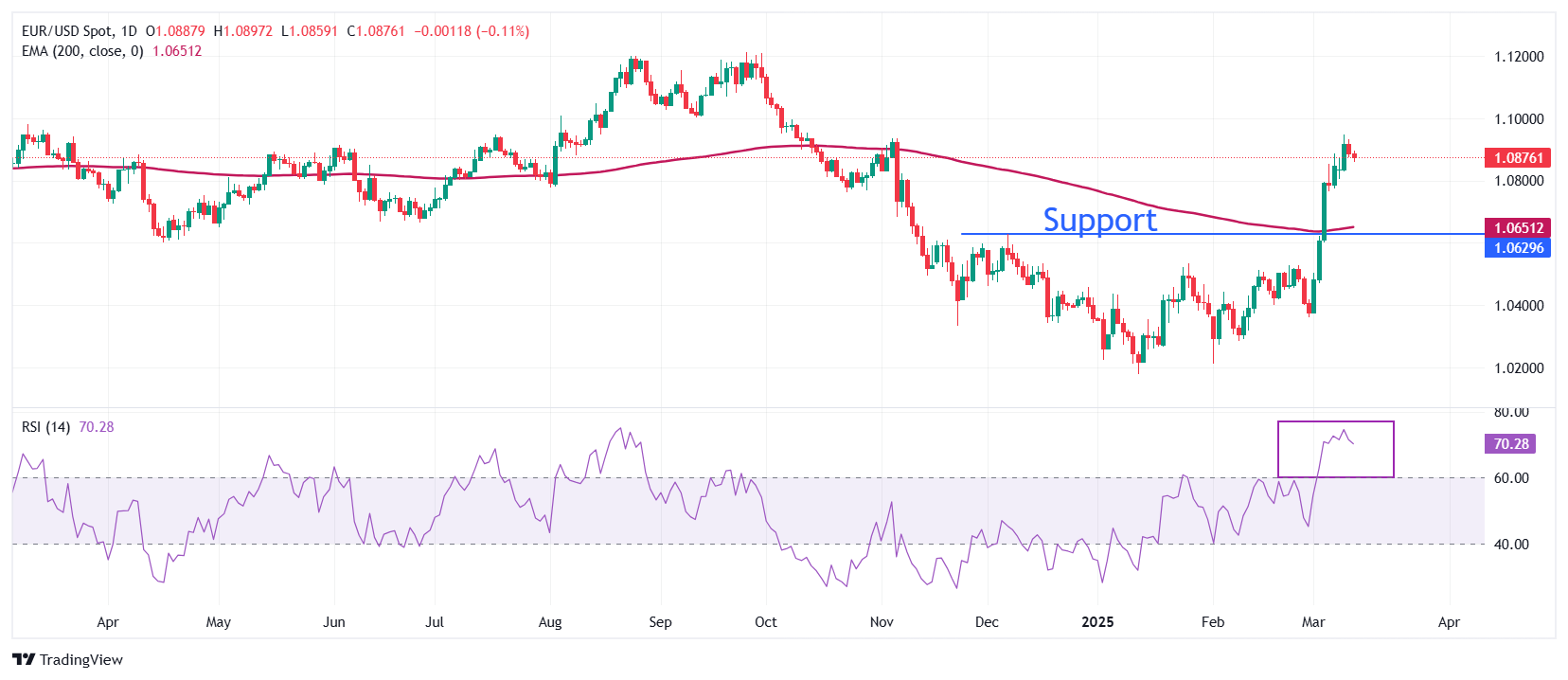- EUR/USD edges lower toward 1.0860 as investors grow cautious over the EU-US trade outlook.
- US President Trump warns of retaliation against the EU’s proposed counter-tariffs.
- Market focus shifts to Germany’s leadership meeting on a potential debt restructuring plan.
EUR/USD corrects toward 1.0860 during European trading hours on Thursday as the Euro (EUR) faces pressure due to escalating trade tensions between the European Union (EU) and the United States (US).
On Wednesday, US President Donald Trump announced plans to retaliate against the EU’s proposed counter-tariffs on €26 billion worth of US goods. His remarks, made just before a meeting with Irish Prime Minister Micheál Martin, included criticism of trade imbalances and a pledge to impose reciprocal tariffs on countries he claims have taken advantage of the US.
During Wednesday’s European session, European Commission (EC) President Ursula von der Leyen introduced "swift and proportionate countermeasures" against US imports in response to recently implemented 25% tariffs on steel and aluminum. The trade conflict is expected to weigh heavily on the German economy, the Eurozone’s largest exporter to the US. In an interview with BBC News, European Central Bank (ECB) policymaker and Bundesbank President Joachim Nagel warned that US tariffs on EU exports could push Germany into a recession this year.
Investors remain cautious ahead of a key meeting of German leaders to discuss debt restructuring aimed at boosting defense spending and economic growth. German debt reform is expected to pass the lower house of Parliament next Tuesday, following negotiations led by Green Party member Franziska Brantner with potential future Chancellor Friedrich Merz and Social Democratic Party (SPD) co-leader Lars Klingbei.
Despite recent trade concerns, the Euro has remained relatively resilient as traders anticipate that Germany’s debt restructuring plan will be inflationary, potentially forcing the ECB to reconsider its dovish stance.
Daily Digest Market Movers: EUR/USD Dips as US Dollar Holds Firm Despite Cooling Inflation
- The US Dollar finds support as concerns over President Trump’s tariff policies drive demand for safe-haven assets. The US Dollar Index (DXY), which measures the Greenback against a basket of six major currencies, edges higher to around 103.65, though it remains near its four-month low of 103.20.
- Despite its modest recovery, the Dollar’s upside is limited as US inflation continues to cool faster than anticipated. In the year through February, headline and core Consumer Price Index (CPI) figures slowed to 2.8% and 3.1%, respectively, while monthly CPI growth stood at 0.2%, below the expected 0.3%. Softer inflation data increases speculation that the Federal Reserve (Fed) may shift toward policy easing, with the CME FedWatch tool reflecting a 78% probability of a rate cut in June.
- Looking ahead, the next key event for the US Dollar will be the Fed’s two-day monetary policy meeting on March 18-19. The central bank is widely expected to hold interest rates steady at 4.25%-4.50%, but investors will closely analyze its guidance on inflation and economic policy under President Trump’s administration.
- In Thursday’s session, market participants will turn their attention to the US Producer Price Index (PPI) data for February, scheduled for release at 12:30 GMT, which could provide further insight into inflation trends and the Fed’s next policy moves.
Technical Analysis: EUR/USD Pulls Back After Hitting Five-Month High at 1.0950

EUR/USD retreats to around 1.0860 on Thursday, extending its correction after reaching a fresh five-month high near 1.0950 on Tuesday. The pair gained momentum following a decisive breakout above the December 6 high of 1.0630 on March 5. Despite the pullback, the long-term outlook remains bullish as the pair continues to trade above the 200-day Exponential Moving Average (EMA), which hovers near 1.0650.
The 14-day Relative Strength Index (RSI) remains close to 75.00, indicating strong bullish momentum.
On the downside, the December 6 high of 1.0630 serves as a crucial support level. Conversely, the psychological barrier at 1.1000 will be a key resistance level for Euro bulls.





